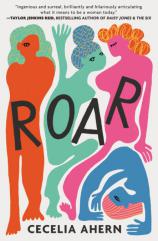Roar
Review
Roar
“I’m here, I’m here, I’m here, I’m here,” murmurs a 58-year-old woman who began gradually fading away and shimmering like a ghost after the onset of menopause. ROAR, Cecelia Ahern’s short story collection, begins with a whisper in this robust opening piece, titled “The Woman Who Slowly Disappeared,” which addresses a brilliant businesswoman’s harmful internalization of ageist stereotypes as she vanishes in a world that she feels disregards her in favor of venerating youth and beauty. “Society told you that you weren’t important, that you didn’t exist, and you listened,” the diminishing woman’s doctor tells her. Liberated by this knowledge, she works towards overcoming age shame through personal empowerment and reclaiming her right to feel “sexy.”
The Disappearing Woman’s chant of “I’m here,” reverberates and rises to a roaring chorus of 30 versatile voices as other women clear their throats and join her in a revitalized esprit de corps throughout the following pages. Like modern fables, these tales teach lessons through the epiphanies of various women, and the heroine of each narrative is referred to anonymously as “the woman.” Ahern is a clever, whimsical fabulist, and the roar of each tale resounds in the moral. Her bold and unapologetic style is augmented by the dream-like, exaggerated quality of these chimerical stories.
"In Ahern’s more successful pieces, her prose flexes its muscles with vim and vigor, and this sinewy, bizarre compilation is an entertaining commentary on the shapeshifting social mores of our times."
Ahern often plays mischievously with idioms, employing them in a literal sense. “The Woman Who Had a Strong Suit” is perplexed during a job interview when she is asked what her strong suit is and, haunted by this interview question, goes on a quest to find her mysterious and magical armor in a department store. In “The Woman Who Unraveled,” a woman snags a thread of her skin while rushing through her morning chores and absentmindedly tears an arm and a leg off at the seams as she juggles her multiple obligations. In the meantime, her sister has a “meltdown” and dissolves into a puddle of talking goo. “The Woman Who Was Kept on the Shelf” is treated like a living, breathing trophy by her husband, who only takes her down from her perch to “polish” her. She takes pride in being objectified until she realizes that she has been “foolish to think it should be the only thing” that gives her life meaning.
Many of these fanciful fables are light-hearted and jocose with their absurdly naïve protagonists floating through surreal situations. Others grapple with more serious sociocultural issues, ranging in severity from the dangers of self-absorption through social media in “The Woman Who Blew Away,” to heavier topics such as street harassment, gender politics and reproductive rights.
“The Woman Who Smiled” spotlights the all-too-familiar and vexing sexist cliché of men commanding women to smile, while “The Woman Who Wore Pink” explores a dystopian world of gender segregation in which people are forced by law to wear bracelets identifying themselves as having a “penis” or “vagina,” and must dress in the stereotypical baby blue or bubblegum pink to signify their respective genders. A woman wearing red gets into a politely rude argument with a man who insists on holding a door open for her, and the Gender Police intervene on his behalf, giving her “penalty points” for being a “naughty vagina.” There is also an alarming scene in which the woman in pink feels threatened by two “honorable gentleman,” who aggressively demand to help her carry her shopping bags to her car, and the Gender Police force her to comply.
In “The Woman Who Guarded Gonads,” a man is refused a vasectomy and chastised for wanting to deny his sperm “its right to life.” Echoing the women’s reproductive rights slogan, “My body, my choice,” the man counters, “It’s my right to choose what I do with my sperm.” Outside the clinic, a woman who is a pro-life zealot protests vasectomies by brandishing a vulgar sign displaying male genitals and the words “SAVE SEMEN.”
In keeping with the title of ROAR, Ahern often opines her political views with a megaphone. While this blunt approach is in accordance with the cautionary epimythia of traditional fables, the technique may come across as a bit too didactic to some readers, and the blaring political messages risk eclipsing the artistry of these tales. Another weakness of this collection is the dicey treatment of too many hackneyed idioms as found objects. Like one of Marcel Duchamp’s readymades, an artist can sign his name on a urinal and call it a fountain, but to most of us, it’s still just a urinal.
ROAR, like many short story ensembles, has its hits and misses. In Ahern’s more successful pieces, her prose flexes its muscles with vim and vigor, and this sinewy, bizarre compilation is an entertaining commentary on the shapeshifting social mores of our times.
Reviewed by Rachel McConnell on April 19, 2019
Roar
- Publication Date: June 16, 2020
- Genres: Fiction, Short Stories
- Paperback: 320 pages
- Publisher: Grand Central Publishing
- ISBN-10: 1538746573
- ISBN-13: 9781538746578




